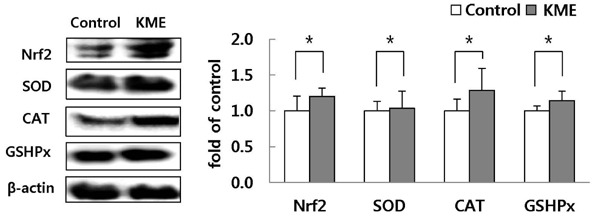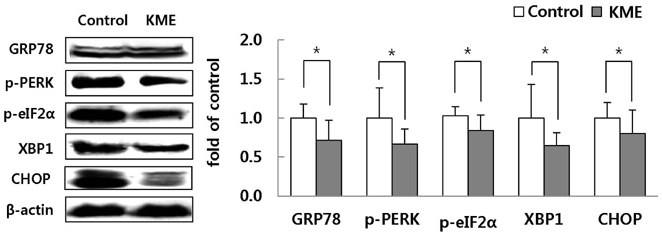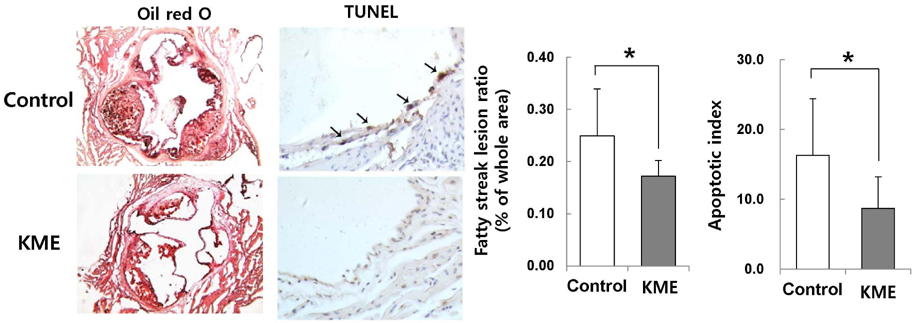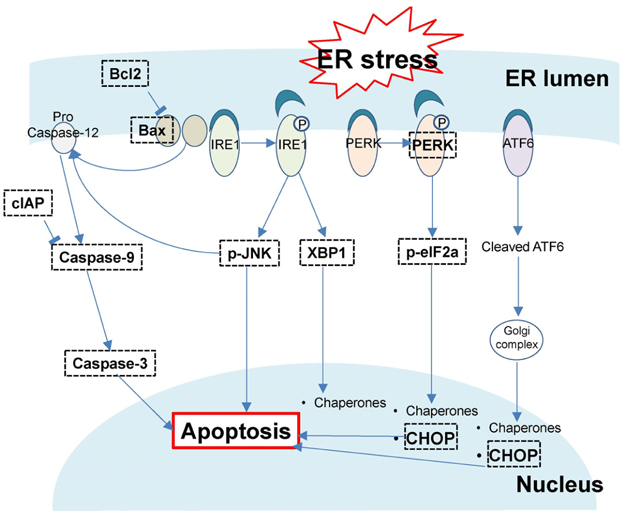Nutr Res Pract.
2017 Dec;11(6):445-451. 10.4162/nrp.2017.11.6.445.
Kimchi attenuates fatty streak formation in the aorta of low-density lipoprotein receptor knockout mice via inhibition of endoplasmic reticulum stress and apoptosis
- Affiliations
-
- 1Department of Food Science and Nutrition, Kimchi Research Institute, Pusan National University, 2, Busandaehak-ro 63 beon-gil, Geumjeong-gu, Busan 46241, Korea. yosong@pusan.ac.kr
- 2Department of Food Science and Nutrition, Tongmyong University, Busan 48520, Korea.
- 3Department of Medicinal Crop Research, National Institute of Horticultural and Herbal Science, Rural Development Administration, Eumseong 55365, Korea.
- KMID: 2395298
- DOI: http://doi.org/10.4162/nrp.2017.11.6.445
Abstract
- BACKGROUND/OBJECTIVES
Endoplasmic reticulum (ER) stress is positively associated with atherosclerosis via elevating macrophage cell death and plaque formation, in which oxidative stress plays a pivotal role. Antioxidative, lipid-lowering, and anti-atherogenic effects of kimchi, a Korean fermented vegetable, have been established, wherein capsaicin, ascorbic acid, quercetin, 3-(4'-hydroxyl-3',5'-dimethoxyphenyl)propionic acid, and lactic acids were identified. In this study, mechanisms of action of kimchi methanol extracts (KME) on fatty streak formation via suppression of ER stress and apoptosis in aorta were examined in low-density lipoprotein receptor knockout mice.
MATERIALS AND METHODS
Mice fed a high cholesterol diet with an oral administration of KME (KME group, 200 mg·kg-bw⻹·day⻹) or distilled water (control group) for 8 weeks (n = 20 for group). Plasma lipid and oxidative stress levels were evaluated. Protein expression was measured by western blot assay. Fatty streak lesion size and the degree of apoptosis were examined in the aorta.
RESULTS
Compared to the control group, in the KME group, plasma lipids levels were decreased and oxidative stress was alleviated (P < 0.05). Protein expression levels of nuclear factor (erythroid-derived 2)-like 2-mediated antioxidants in aorta were increased whereas those for ER stress markers, glucose regulated protein 78, phospho-protein kinase RNA-like ER kinase, phospho-eukaryotic initiation factor 2 subunit α, X-box binding protein 1, and C/EBP homologous protein were decreased in the KME group (P < 0.05). Moreover, apoptosis was suppressed via downregulation of phospho-c-Jun N-terminal kinase, bcl-2-associated X protein, caspases-9, and -3 with a concomitant upregulation of anti-apoptotic protein, B-cell lymphoma 2 (P < 0.05). Fatty streak lesion size was reduced and the degree of apoptosis was less severe in the KME group (P < 0.05).
CONCLUSIONS
In conclusion, antioxidant activity of KME might prevent fatty streak formation through, in part, inhibition of ER stress and apoptosis in aortic sinus where macrophages are harbored.
MeSH Terms
-
Administration, Oral
Animals
Antioxidants
Aorta*
Apoptosis*
Ascorbic Acid
Atherosclerosis
bcl-2-Associated X Protein
Blotting, Western
Capsaicin
Carrier Proteins
Cell Death
Cholesterol
Diet
Down-Regulation
Endoplasmic Reticulum Stress*
Endoplasmic Reticulum*
Glucose
Hypercholesterolemia
Lactic Acid
Lipoproteins*
Lymphoma, B-Cell
Macrophages
Methanol
Mice
Mice, Knockout*
Oxidative Stress
Phosphotransferases
Plasma
Prokaryotic Initiation Factor-2
Quercetin
Receptors, Lipoprotein*
Sinus of Valsalva
Up-Regulation
Vegetables
Water
Antioxidants
Ascorbic Acid
Capsaicin
Carrier Proteins
Cholesterol
Glucose
Lactic Acid
Lipoproteins
Methanol
Phosphotransferases
Prokaryotic Initiation Factor-2
Quercetin
Receptors, Lipoprotein
Water
bcl-2-Associated X Protein
Figure
Reference
-
1. Hulsmans M, Holvoet P. The vicious circle between oxidative stress and inflammation in atherosclerosis. J Cell Mol Med. 2010; 14:70–78.
Article2. Scull CM, Tabas I. Mechanisms of ER stress-induced apoptosis in atherosclerosis. Arterioscler Thromb Vasc Biol. 2011; 31:2792–2797.
Article3. Hotamisligil GS. Endoplasmic reticulum stress and atherosclerosis. Nat Med. 2010; 16:396–399.
Article4. Tsukano H, Gotoh T, Endo M, Miyata K, Tazume H, Kadomatsu T, Yano M, Iwawaki T, Kohno K, Araki K, Mizuta H, Oike Y. The endoplasmic reticulum stress-C/EBP homologous protein pathway-mediated apoptosis in macrophages contributes to the instability of atherosclerotic plaques. Arterioscler Thromb Vasc Biol. 2010; 30:1925–1932.
Article5. Zhai CL, Zhang MQ, Zhang Y, Xu HX, Wang JM, An GP, Wang YY, Li L. Glycyrrhizin protects rat heart against ischemia-reperfusion injury through blockade of HMGB1-dependent phospho-JNK/Bax pathway. Acta Pharmacol Sin. 2012; 33:1477–1487.
Article6. Urano F, Wang X, Bertolotti A, Zhang Y, Chung P, Harding HP, Ron D. Coupling of stress in the ER to activation of JNK protein kinases by transmembrane protein kinase IRE1. Science. 2000; 287:664–666.
Article7. Kim BK, Choi JM, Kang SA, Park KY, Cho EJ. Antioxidative effects of kimchi under different fermentation stage on radical-induced oxidative stress. Nutr Res Pract. 2014; 8:638–643.
Article8. Choi IH, Noh JS, Han JS, Kim HJ, Han ES, Song YO. Kimchi, a fermented vegetable, improves serum lipid profiles in healthy young adults: randomized clinical trial. J Med Food. 2013; 16:223–229.
Article9. Jung K, Hong SH, Kim M, Han JS, Jang MS, Song YO. Antiatherogenic effects of Korean cabbage kimchi with added short arm octopus. Food Sci Biotechnol. 2015; 24:249–255.
Article10. Park KY, Jeong JK, Lee YE, Daily JW 3rd. Health benefits of kimchi (Korean fermented vegetables) as a probiotic food. J Med Food. 2014; 17:6–20.
Article11. Woo M, Kim M, Noh JS, Song YO. Kimchi methanol extracts attenuate hepatic steatosis induced by high cholesterol diet in low-density lipoprotein receptor knockout mice through inhibition of endoplasmic reticulum stress. J Funct Foods. 2017; 32:218–225.
Article12. Jeong SM, Kang MJ, Choi HN, Kim JH, Kim JI. Quercetin ameliorates hyperglycemia and dyslipidemia and improves antioxidant status in type 2 diabetic db/db mice. Nutr Res Pract. 2012; 6:201–207.
Article13. Srinivasan K. Biological activities of red pepper (Capsicum annuum) and its pungent principle capsaicin: a review. Crit Rev Food Sci Nutr. 2016; 56:1488–1500.
Article14. Bogdański P, Suliburska J, Szulińska M, Sikora M, Walkowiak J, Jakubowski H. L-Arginine and vitamin C attenuate pro-atherogenic effects of high-fat diet on biomarkers of endothelial dysfunction in rats. Biomed Pharmacother. 2015; 76:100–106.
Article15. Noh JS, Kim HJ, Kwon MJ, Song YO. Active principle of kimchi, 3-(4'-hydroxyl-3',5'-dimethoxyphenyl)propionic acid, retards fatty streak formation at aortic sinus of apolipoprotein E knockout mice. J Med Food. 2009; 12:1206–1212.
Article16. Kim HJ, Lee JS, Chung HY, Song SH, Suh H, Noh JS, Song YO. 3-(4'-hydroxyl-3',5'-dimethoxyphenyl)propionic acid, an active principle of kimchi, inhibits development of atherosclerosis in rabbits. J Agric Food Chem. 2007; 55:10486–10492.
Article17. Noh JS, Choi YH, Song YO. Beneficial effects of the active principle component of Korean cabbage kimchi via increasing nitric oxide production and suppressing inflammation in the aorta of apoE knockout mice. Br J Nutr. 2013; 109:17–24.
Article18. Jeong JW, Choi IW, Jo GH, Kim GY, Kim J, Suh H, Ryu CH, Kim WJ, Park KY, Choi YH. Anti-inflammatory effects of 3-(4'-hydroxyl-3',5'-dimethoxyphenyl) propionic acid, an active component of Korean cabbage kimchi, in lipopolysaccharide-stimulated BV2 microglia. J Med Food. 2015; 18:677–684.
Article19. Kim HJ, Sung YB, Song YO, Kang M, Kim TW, Park SH, Jang JY. Kimchi suppresses 7-ketocholesterol-induced endoplasmic reticulum stress in macrophages. Food Sci Biotechnol. 2012; 21:1293–1299.
Article20. Paigen B, Morrow A, Brandon C, Mitchell D, Holmes P. Variation in susceptibility to atherosclerosis among inbred strains of mice. Atherosclerosis. 1985; 57:65–73.
Article21. Friedewald WT, Levy RI, Fredrickson DS. Estimation of the concentration of low-density lipoprotein cholesterol in plasma, without use of the preparative ultracentrifuge. Clin Chem. 1972; 18:499–502.
Article22. Ali SF, LeBel CP, Bondy SC. Reactive oxygen species formation as a biomarker of methylmercury and trimethyltin neurotoxicity. Neurotoxicology. 1992; 13:637–648.23. Kooy NW, Royall JA, Ischiropoulos H, Beckman JS. Peroxynitrite-mediated oxidation of dihydrorhodamine 123. Free Radic Biol Med. 1994; 16:149–156.
Article24. Zemplenyi T, Grafnetter D. Species and sex differences in fatty acid release by tissues incubated with lipaemic human serum. Br J Exp Pathol. 1958; 39:99–108.25. Inoguchi T, Battan R, Handler E, Sportsman JR, Heath W, King GL. Preferential elevation of protein kinase C isoform beta II and diacylglycerol levels in the aorta and heart of diabetic rats: differential reversibility to glycemic control by islet cell transplantation. Proc Natl Acad Sci U S A. 1992; 89:11059–11063.
Article26. Bai Y, Tan Y, Wang B, Miao X, Chen Q, Zheng Y, Cai L. Deletion of angiotensin II type 1 receptor gene or scavenge of superoxide prevents chronic alcohol-induced aortic damage and remodelling. J Cell Mol Med. 2012; 16:2530–2538.
Article27. Dong Y, Zhang M, Liang B, Xie Z, Zhao Z, Asfa S, Choi HC, Zou MH. Reduction of AMP-activated protein kinase α2 increases endoplasmic reticulum stress and atherosclerosis in vivo. Circulation. 2010; 121:792–803.
Article28. Chan AY, Soltys CL, Young ME, Proud CG, Dyck JR. Activation of AMP-activated protein kinase inhibits protein synthesis associated with hypertrophy in the cardiac myocyte. J Biol Chem. 2004; 279:32771–32779.
Article29. Dickhout JG, Colgan SM, Lhoták S, Austin RC. Increased endoplasmic reticulum stress in atherosclerotic plaques associated with acute coronary syndrome: a balancing act between plaque stability and rupture. Circulation. 2007; 116:1214–1216.
Article30. Chen J, Deng X, Liu N, Li M, Liu B, Fu Q, Qu R, Ma S. Quercetin attenuates tau hyperphosphorylation and improves cognitive disorder via suppression of ER stress in a manner dependent on AMPK pathway. J Funct Foods. 2016; 22:463–476.
Article31. Thorp E, Li G, Seimon TA, Kuriakose G, Ron D, Tabas I. Reduced apoptosis and plaque necrosis in advanced atherosclerotic lesions of Apoe-/- and Ldlr-/- mice lacking CHOP. Cell Metab. 2009; 9:474–481.
Article32. Zong WX, Li C, Hatzivassiliou G, Lindsten T, Yu QC, Yuan J, Thompson CB. Bax and Bak can localize to the endoplasmic reticulum to initiate apoptosis. J Cell Biol. 2003; 162:59–69.
Article33. Thorp E, Li Y, Bao L, Yao PM, Kuriakose G, Rong J, Fisher EA, Tabas I. Brief report: increased apoptosis in advanced atherosclerotic lesions of Apoe-/- mice lacking macrophage Bcl-2. Arterioscler Thromb Vasc Biol. 2009; 29:169–172.
Article34. Yang Z, Liu Y, Deng W, Dai J, Li F, Yuan Y, Wu Q, Zhou H, Bian Z, Tang Q. Hesperetin attenuates mitochondria-dependent apoptosis in lipopolysaccharide-induced H9C2 cardiomyocytes. Mol Med Rep. 2014; 9:1941–1946.
Article
- Full Text Links
- Actions
-
Cited
- CITED
-
- Close
- Share
- Similar articles
-
- Endoplasmic Reticulum Stress Responses and Apoptosis
- Endoplasmic Reticulum Stress and Diabetes
- Endoplasmic Reticulum Stress-Mediated p62 Downregulation Inhibits Apoptosis via c-Jun Upregulation
- Effects of Chronic Mild Stress in Female Bax Inhibitor-1-Gene Knockout Mice
- Characterization of Endoplasmic Reticulum Stress and Apoptosis in Macrophages Infected with Mycobacterium tuberculosis Isolates from Korea Patients






